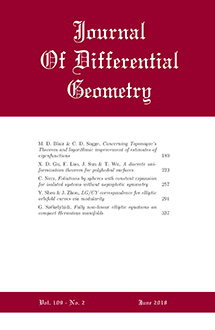Abstract
Entropy is a natural geometric quantity measuring the complexity of a surface embedded in $\mathbb{R}^3$. For dynamical reasons relating to mean curvature flow, Colding–Ilmanen–Minicozzi–White conjectured (since proved by Bernstein–Wang) that the entropy of any closed surface is at least that of the self-shrinking two-sphere. In this paper we give an alternative proof of their conjecture for closed embedded 2-spheres. Our results can be thought of as the parabolic analog to the Willmore conjecture and our argument is analogous in many ways to that of Marques–Neves on the Willmore problem. The main tool is the min-max theory applied to the Gaussian area functional in $\mathbb{R}^3$ which we also establish. To any closed surface in $\mathbb{R}^3$ we associate a four parameter canonical family of surfaces and run a min-max procedure. The key step is ruling out the min-max sequence approaching a self-shrinking plane, and we accomplish this with a degree argument. To establish the min-max theory for $\mathbb{R}^3$ with Gaussian weight, the crucial ingredient is a tightening map that decreases the mass of nonstationary varifolds (with respect to the Gaussian metric of $\mathbb{R}^3$) in a continuous manner.
Funding Statement
The first author is partially supported by an NSF Postdoctoral Fellowship. The second author is partially supported by NSF grant DMS-1406337.
Citation
Daniel Ketover. Xin Zhou. "Entropy of closed surfaces and min-max theory." J. Differential Geom. 110 (1) 31 - 71, September 2018. https://doi.org/10.4310/jdg/1536285626





